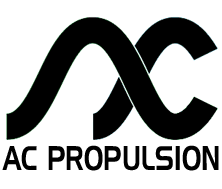AC Propulsion
AC Propulsion is a San Dimas, California, USA company founded in 1992 by Alan Cocconi, Wally Rippel, and Paul Carosa, that specializes in alternating current-based drivetrain systems for electric vehicles.[1][2] It offers AC-induction traction motors.[3] The company produces electric vehicle drive systems featuring high performance, high efficiency induction motors and integrated high power battery charging.[3][4] Previously, they built an electric sports car, the tzero[2] and the eBox,[2] an electric conversion based on the Scion XB. They also develop prototype electric vehicles for OEM customers.

Founder Alan Cocconi designed and built the controller used in the original GM Impact, which later became the GM EV1. ACP introduced the first AC-100 in 1992 and the AC-150 150 kW (200 hp) integrated drive system in 1994.[5] The AC-150 has been used in a variety of applications such as the BMW Mini E, Foton Midi taxi and a USPS LLV demo vehicle. AC Propulsion is a leader in Vehicle to grid or V2G systems,[2] with their second generation AC-150 drivetrain offering a bidirectional grid power connection.
The company works with automobile manufacturers such as Changan Automobile.[6]
Vehicles using an AC Propulsion electric drivetrain
- AC Propulsion tzero
- AC Propulsion eBox
- Volvo 3CC
- Venturi Fetish
- Courreges EXE
- Courreges ZOOOP (with lithium polymer batteries)
- Wrightspeed X1 (based on the Ariel Atom)
- Mini E[2][5][7]
- Peraves E-Tracer
- Toyota RAV4 EV[8]
- Tesla Roadster (2008)
- Martin Eberhard and Elon Musk had both taken test drives in the lithium-ion battery powered revision of the AC Propulsion tzero before joining Tesla Motors. Martin Eberhard encouraged Tom Gage and Alan Cocconi to move their prototype tzero into production. When they declined, in favor of working on their electrified Scion xB called the eBox, Martin Eberhard and Marc Tarpenning incorporated Tesla Motors to pursue the idea of building an electric roadster in the spirit of the tzero. Elon Musk later test drove the tzero as well, and he also encouraged AC Propulsion to commercialize the vehicle. Tom Gage again deferred, but put Elon Musk in contact with Martin Eberhard.[9]
- Before Tesla Motors developed its Roadster's proprietary powertrain, the company licensed AC Propulsion's EV Power System design and Reductive Charging patent which covers integration of the charging electronics with the inverter, thus reducing mass, complexity, and cost. Tesla then designed and built its own power electronics, motor, and other drivetrain components that incorporated this licensed technology from AC Propulsion.[10][11][12] Given the extensive redevelopment of the vehicle, Tesla Motors no longer licenses any proprietary technology from AC Propulsion.[13]
References
- Zorpette, Glenn. (May 1997) Profile: Alan Cocconi – Electric Cars and Pterosaurs are my Business (subscription required), Scientific American 276(5), 32-36. Archive from 1998
- "AC Propulsion - Creating electric vehicles that people want to drive". Archived from the original on 2016-12-20. Retrieved 2014-06-10.
- "AC Propulsion, Inc.: Private Company Information - Businessweek".
- "AC Propulsion - Creating electric vehicles that people want to drive". Archived from the original on 2014-07-11. Retrieved 2014-06-10.
- "iCloud".
- MEETING WITH CHANGAN AUTOMOBILE AT ACP Published: 05 December 2017
- "AC Propulsion - Creating electric vehicles that people want to drive".
- "Sacramento, Here We Come!" (PDF). Convention and Tradeshow News. 2001-12-12. p. 1. Archived (PDF) from the original on 2019-02-24.
AC Propulsion’s battery electric Toyota RAV4-EV made it from Southern California to ETIC2001 without stopping to charge.
- Siry, Darryl (2009-06-25). "Will the Real Tesla Founder Please Stand Up?". Condé Nast. Archived from the original on 2019-09-21.
...it is interesting to note that neither Martin Eberhard or Elon Musk came up with the idea of an electric sportscar with excellent range and amazing acceleration. As is evident in some of the emails Elon presents on his blog, the credit rests with a company few outside EV circles has heard of. AC Propulsion developed the idea, and both Eberhard and Musk initially approached the San Dimas, California, company to build the car. Tom Gage and Alan Cocconi had built the t zero, which is essentially the prototypical Tesla Roadster with a 0-60 time of 3.6 seconds and a range of more than 200 miles using commodity lithium-ion cells. One way to look at this is the real technology visionaries were the folks at AC Propulsion, but they lacked the entrepreneurial vision to see just how big an idea it could become and the means to achieve it. Both Eberhard and Musk saw the importance — and potential — of what Gage and Cocconi had created. When Eberhard and Musk approached them individually to prod them into taking the next step and produce the vehicle, Gage opted instead to introduce Musk to Eberhard and get back to work creating the eBox, an electrified Scion xB that Gage considered more practical and economical.
- "Reductive Charging, AC Propulsion's Reductive Charger Integrated Charging for the Electric Vehicle". AC Propulsion. Archived from the original on 2007-02-06. Retrieved 2007-03-07.
- Sam Abuelsamid (2008-06-24). "AutoblogGreen Q&A: Tesla Motors Chairman Elon Musk Part 2 – Transmission shifts". Retrieved 2008-06-24.
- Tarpenning, Marc; Martin Eberhard (2007-08-24). "Well-to-Wheel Energy Efficiency". Tesla Motors. Archived from the original on 2007-10-11. Retrieved 2011-02-25.
The AC Propulsion lithium-ion charging system (the basis for the design of the Tesla Roadster charging system)...
- Elon Musk (2009-06-22). "Tesla Leadership". Tesla Motors. Archived from the original on June 24, 2009. Retrieved 2009-08-01.
Tesla Motors, Inc. consisted of Eberhard, Tarpenning and Wright, plus an unfunded business plan and they were looking for an initial round of funding to create a more advanced prototype than the AC Propulsion Tzero. While there was a basic corporation in place, Tesla hadn't even registered or obtained the trademark to its name and had no formal offices or assets. To save legal fees, we just copied the SpaceX articles of incorporation and bylaws for Tesla and I invested $6.35M (98%) of the initial closing of $6.5M in Series A funding. Eberhard invested $75k (approximately 1%).